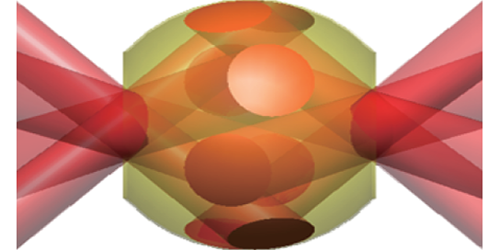April 21, 2017 report
New laser technique improves neutron yield

(Phys.org)—A team of researchers from several institutions in China has developed a new way to produce neutrons that they claim improves on conventional methods by a factor of 100. In their paper published in the journal Physical Review Letters, the team describes the new method and the results they obtained when testing it.
Neutrons are used for a variety of purposes, including academic pursuits and real-world applications such as underground mineral resource location. For that reason, scientists continue to look for new and better sources. Currently, in one approach, lasers are fired at hydrogen isotope clusters, which causes them to be ionized and to collide, resulting in fusion reactions that release neutrons. Unfortunately, this approach and others are not very efficient. In this new effort, the researchers have taken a new approach to using lasers to produce neutrons—applying the force from the inside rather than the outside.
In the new method, a laser is used to heat a deuterium capsule, which fuses deuterium nuclei pairs, resulting in neutron emissions. The method is a form of inertial confinement fusion, but the instability inherent in other techniques has been improved by using what the team terms "spherically convergent plasma fusion." In this method, the researchers used a spherical capsule covered with a thin layer of gold; the capsule had an inside coating of polystyrene containing an amount of deuterium. The researchers then cut tiny holes in the coating and fired lasers through them, allowing the beams to strike inside the capsule, instigating a fusion reaction and emittance of neutrons. The team used 2 ns 6.3 kJ laser pulses to test their method, and report that they were able to produce approximately 1 billion neutrons for each pulse, which they claim is approximately 100 times better than other methods.
The team also suggest that if the target used were deuterium and tritium, it might be possible to boost output by a factor of 1000. They further suggest it might be possible to scale up their method to produce even greater amounts of the subatomic particles.
More information: G. Ren et al. Neutron Generation by Laser-Driven Spherically Convergent Plasma Fusion, Physical Review Letters (2017). DOI: 10.1103/PhysRevLett.118.165001
ABSTRACT
We investigate a new laser-driven spherically convergent plasma fusion scheme (SCPF) that can produce thermonuclear neutrons stably and efficiently. In the SCPF scheme, laser beams of nanosecond pulse duration and 1014–1015 W/cm2 intensity uniformly irradiate the fuel layer lined inside a spherical hohlraum. The fuel layer is ablated and heated to expand inwards. Eventually, the hot fuel plasmas converge, collide, merge, and stagnate at the central region, converting most of their kinetic energy to internal energy, forming a thermonuclear fusion fireball. With the assumptions of steady ablation and adiabatic expansion, we theoretically predict the neutron yield Yn to be related to the laser energy EL, the hohlraum radius Rh, and the pulse duration τ through a scaling law of Yn ∝ (EL/Rh1.2τ0.2)2.5. We have done experiments at the ShengGuangIII-prototype facility to demonstrate the principle of the SCPF scheme. Some important implications are discussed.
Journal information: Physical Review Letters
© 2017 Phys.org


















